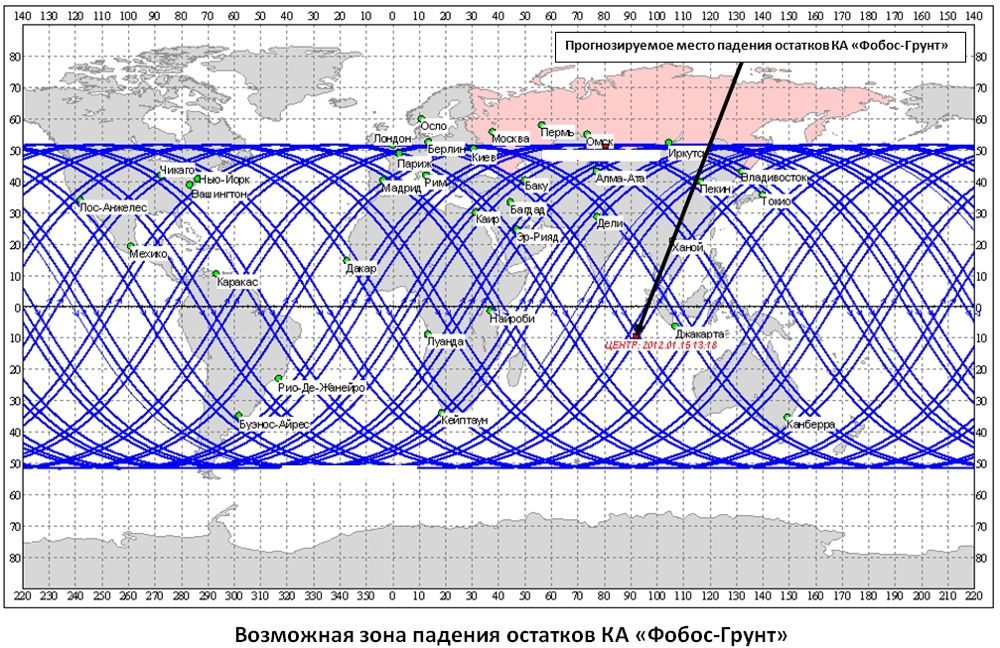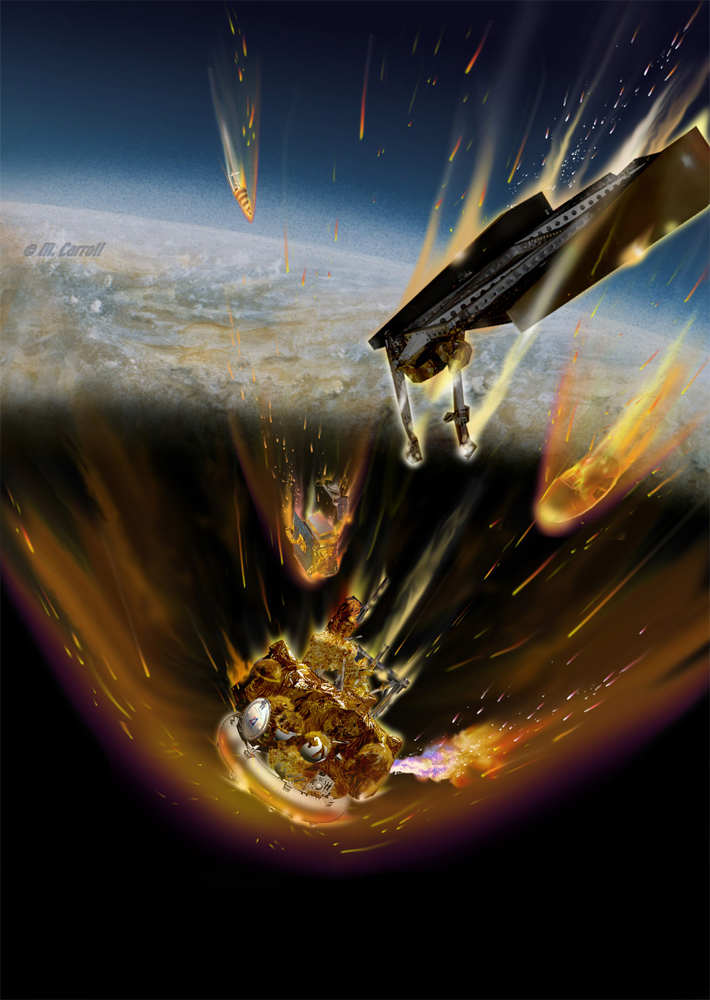
A doomed Russian Mars probe that's been stuck in Earth orbit for two months may finally come crashing down Sunday (Jan. 15) over the Indian Ocean, Russian space officials say.
The 14.5-ton Phobos-Grunt spacecraft should fall back to Earth sometime between Saturday and Monday (Jan. 14 to Jan. 16), Russia's Federal Space Agency, known as Roscosmos, announced in a statement today (Jan. 11).
If Phobos-Grunt comes down at the "central point" in that window — 4:18 a.m. EST (0918 GMT) on Sunday — it will fall over a stretch of empty ocean west of the Indonesian island of Java, according to a re-entry projection map Roscosmos published with the update.
But these projections are far from set in stone. The predicted time and place of re-entry may change as engineers continue to track the spacecraft's decaying orbit, officials said. All that's known for sure is that Phobos-Grunt will come down somewhere between 51 degrees north latitude and 51 degrees south latitude. [Photos of the Phobos-Grunt mission]
Falling back to Earth
Phobos-Grunt launched Nov. 8 on a mission to collect soil samples from the Mars moon Phobos and return them to Earth ("grunt" means "soil" in Russian). However, the probe's main engines failed to fire as planned to send it toward Mars, and the craft got stuck orbiting Earth.
Russian officials still aren't sure what caused the failure. They recently raised the possibility that some form of sabotage may have crippled Phobos-Grunt and doomed its $165 million mission.
Get the Space.com Newsletter
Breaking space news, the latest updates on rocket launches, skywatching events and more!
The spacecraft has been spiraling lower and lower for months, on an inevitable collision course with Earth's atmosphere. The minimum altitude of Phobos-Grunt's orbit as of today is about 106 miles (171 kilometers), according to Roscosmos.
The huge probe is carrying about 7.5 tons of toxic hydrazine fuel, prompting some observers to worry about potential environmental impacts of the probe's looming re-entry. Russian space officials have repeatedly dismissed those concerns, however, saying that the fuel — which is encased in an aluminum tank — should burn up high in Earth's atmosphere.
Most of Phobos-Grunt should meet that same fate. Experts predict that just 20 to 30 pieces, weighing a maximum of 440 pounds (200 kilograms) in total, will actually hit the Earth.
Phobos-Grunt's demise comes close on the heels of two other uncontrolled satellite falls recently. NASA's 6.5-ton UARS climate satellite re-entered over the Pacific Ocean in September, and Germany's 2.7-ton ROSAT satellite crashed over the Indian Ocean a month later.
Both the UARS and ROSAT re-entries were expected, however, and the two satellites had long since completed their primary science missions. No one on the ground was hurt in either instance.

A series of Russian space failures
Phobos-Grunt's failure was just one of a series of embarrassing setbacks for the Russian space program in 2011.
On Feb. 1, for example, a Rockot launch vehicle failed to place an Earth-observing satellite in the proper orbit. On Aug. 18, a Proton rocket similarly underperformed, delivering a $300 million communications satellite to the wrong orbit.
Less than a week later, on Aug. 24, the unmanned Progress 44 supply ship crashed while hauling cargo to the International Space Station. Progress 44 was done in by a problem with its Soyuz rocket. Russia uses a similar version of the Soyuz to launch astronauts to the space station, so manned flights were put on hold until the problem with the rocket could be identified and fixed.
Finally, a Soyuz-2 rocket crashed just after liftoff on Dec. 23, destroying a Russian military communications satellite.
You can follow SPACE.com senior writer Mike Wall on Twitter: @michaeldwall. Follow SPACE.com for the latest in space science and exploration news on Twitter @Spacedotcom and on Facebook.
Join our Space Forums to keep talking space on the latest missions, night sky and more! And if you have a news tip, correction or comment, let us know at: community@space.com.

Michael Wall is a Senior Space Writer with Space.com and joined the team in 2010. He primarily covers exoplanets, spaceflight and military space, but has been known to dabble in the space art beat. His book about the search for alien life, "Out There," was published on Nov. 13, 2018. Before becoming a science writer, Michael worked as a herpetologist and wildlife biologist. He has a Ph.D. in evolutionary biology from the University of Sydney, Australia, a bachelor's degree from the University of Arizona, and a graduate certificate in science writing from the University of California, Santa Cruz. To find out what his latest project is, you can follow Michael on Twitter.









